XRP price drops slightly as SEC v. Ripple lawsuit heads towards end of discovery phase
- XRP price noted a drop of 0.76% on Monday as the SEC lawsuit entered the final week of remedies-related discovery phase.
- A federal judge granted Ripple an extension of remedies-related discovery deadline and moved it to February 20, 2024.
- Crypto expert states SEC v. Ripple lawsuit could end as early as 2024 or see a push to 2028 if either party appeals to the Supreme Court.
XRP price climbed 3.70% in the past week and declined slightly on Monday as the SEC v. Ripple lawsuit entered its final week of the discovery phase. The Court granted Ripple’s request for extension of remedies-related discovery deadline from February 12 to 20.
The payment remittance firm is likely compiling its financial statements and institutional sales contracts for the Securities and Exchange Commission (SEC), this week. The payment giant’s lawyers previously stated that the SEC’s request for information is burdensome and Ripple needs time to compile the information.
A crypto expert analyzed the SEC v. Ripple lawsuit and identified seven possible ways in which the lawsuit could end.
Also read: XRP price could deteriorate with Ripple’s request for deadline extension in SEC lawsuit
Daily Digest Market Movers: SEC v. Ripple lawsuit drags on, experts state legal battle could end in 2028
- The SEC v. Ripple lawsuit has been a focal point for XRP holders, given its influence on the altcoin’s price.
- According to the latest development in the lawsuit, the deadline for the remedies-related discovery phase was extended from February 12 to 20.
- This allows more time for the payment remittance firm to gather the information that the SEC seeks.
- The extension of deadlines in the lawsuit could delay the end of the SEC v. Ripple lawsuit.
- A crypto expert behind the X handle @AshleyPROSPER1, analyzed the different scenarios for the lawsuit and predicted that it could end as early as 2024 or as late as 2028.
- The expert explains that the lawsuit could end at any time if the two parties decide to settle. If Ripple and SEC accept the remedies ruling from Judge Analisa Torres with no further appeals from either side, the case could end as early as 2024.
- However, an appeal from either side to the second circuit could send the case to 2026 or 2027. An appeal to the Supreme Court Of the US could see the lawsuit drag until 2028 before a final outcome.
Technical Analysis: XRP price could rally 7% to $0.5629
XRP price dipped slightly on Monday, however the technical indicators show that the altcoin is likely to rally. XRP price is $0.5223 on Binance, at the time of writing. The green bars on the Awesome Oscillator (AO) and the Moving Average Convergence/ Divergence (MACD) support the thesis of gains in XRP price.
XRP price faces resistance at R1, $0.5629. This level is key to XRP since it represents the 50% Fibonacci Retracement of the decline from the 2024 high to the January 31 low of $0.4853. A rally to R1 represents nearly 7% gains in XRP.
The support for XRP price is $0.4968, just below the psychologically important level of $0.50.

XRP/USDT 1-day chart
A daily candlestick close below the support at $0.4968 could invalidate the bullish thesis for XRP price. If XRP price plummets, it could dip to the January 31 low of $0.4853.
Bitcoin, altcoins, stablecoins FAQs
What is Bitcoin?
Bitcoin is the largest cryptocurrency by market capitalization, a virtual currency designed to serve as money. This form of payment cannot be controlled by any one person, group, or entity, which eliminates the need for third-party participation during financial transactions.
What are altcoins?
Altcoins are any cryptocurrency apart from Bitcoin, but some also regard Ethereum as a non-altcoin because it is from these two cryptocurrencies that forking happens. If this is true, then Litecoin is the first altcoin, forked from the Bitcoin protocol and, therefore, an “improved” version of it.
What are stablecoins?
Stablecoins are cryptocurrencies designed to have a stable price, with their value backed by a reserve of the asset it represents. To achieve this, the value of any one stablecoin is pegged to a commodity or financial instrument, such as the US Dollar (USD), with its supply regulated by an algorithm or demand. The main goal of stablecoins is to provide an on/off-ramp for investors willing to trade and invest in cryptocurrencies. Stablecoins also allow investors to store value since cryptocurrencies, in general, are subject to volatility.
What is Bitcoin Dominance?
Bitcoin dominance is the ratio of Bitcoin's market capitalization to the total market capitalization of all cryptocurrencies combined. It provides a clear picture of Bitcoin’s interest among investors. A high BTC dominance typically happens before and during a bull run, in which investors resort to investing in relatively stable and high market capitalization cryptocurrency like Bitcoin. A drop in BTC dominance usually means that investors are moving their capital and/or profits to altcoins in a quest for higher returns, which usually triggers an explosion of altcoin rallies.
